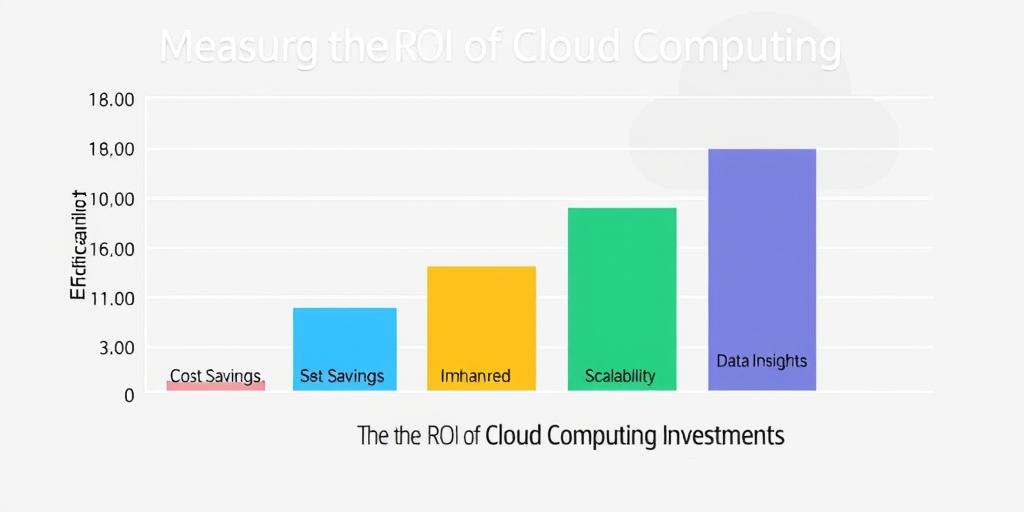In today’s digital landscape, businesses of all sizes are embracing cloud computing to enhance their operations, boost efficiency, and gain a competitive edge. But amidst the hype and promises of cloud adoption, a crucial question arises: how can you effectively measure the return on investment (ROI) of your cloud computing investments? Understanding the cloud ROI is essential to ensure that your cloud migration is delivering tangible benefits and justifying the costs.
The Importance of Measuring ROI
Measuring cloud ROI is not just a financial exercise; it’s a strategic imperative. By quantifying the value you derive from cloud computing, you can demonstrate the impact of your technology investments to stakeholders, secure budget approvals for future initiatives, and optimize cloud usage for maximum return.
Challenges in Measuring Cloud ROI
While the benefits of cloud computing are undeniable, measuring its ROI can be challenging. The complex nature of cloud services, fluctuating costs, and diverse business objectives can make it difficult to pinpoint the exact impact of your cloud investment.
Defining Your Cloud ROI Goals
Before diving into the specifics of measuring cloud ROI, it’s vital to establish clear goals and objectives. This involves identifying the key performance indicators (KPIs) that align with your business priorities and will be used to evaluate the success of your cloud migration.
Identifying Key Performance Indicators (KPIs)
The specific KPIs you choose will depend on your business goals and the nature of your cloud deployment. Some common KPIs include:
- Cost savings: Measure the reduction in IT infrastructure costs, such as hardware, software, and maintenance, after migrating to the cloud.
- Increased efficiency: Assess improvements in application performance, employee productivity, and operational efficiency.
- Scalability and flexibility: Evaluate the ease of scaling your cloud resources up or down to meet changing business demands.
- Security and compliance: Measure the enhanced security posture and compliance with industry regulations achieved through cloud adoption.
Setting Realistic Expectations
It’s important to set realistic expectations for your cloud ROI. Don’t expect overnight miracles. Cloud ROI is a journey, not a destination. It requires ongoing monitoring, analysis, and optimization to achieve tangible results.
Tracking and Measuring Cloud Costs
To calculate cloud ROI accurately, you need to have a clear understanding of your cloud costs. This involves familiarizing yourself with the different cloud billing models and utilizing cost management tools to track your cloud spending.
Understanding Cloud Billing Models
Cloud service providers offer various billing models, such as pay-as-you-go, reserved instances, and spot instances. Each model has its own pricing structure and usage considerations. Understanding these billing models is crucial for accurately calculating cloud costs.
Utilizing Cloud Cost Management Tools
Cloud providers offer a range of cost management tools, including dashboards, reports, and alerts. These tools help you monitor your cloud spending, identify cost optimization opportunities, and allocate resources effectively.
Analyzing Cost Trends and Optimizations
Regularly analyze your cloud cost data to identify trends, pinpoint areas of overspending, and implement optimization strategies. This could involve right-sizing instances, utilizing reserved instances, and leveraging cost-effective cloud services.
Measuring Cloud Benefits
While tracking cloud costs is essential, it’s only half the equation. You also need to measure the benefits you derive from cloud computing.
Increased Efficiency and Productivity
Cloud computing can significantly improve efficiency and productivity by streamlining processes, automating tasks, and providing access to on-demand resources. Measure the impact of these improvements on employee productivity and business operations.
Improved Scalability and Flexibility
Cloud computing offers unparalleled scalability and flexibility, allowing you to adjust your resources quickly to meet changing demands. Track how your cloud deployment has enabled you to scale your business operations effectively.
Enhanced Security and Compliance
Cloud providers invest heavily in security infrastructure and compliance frameworks. Measure the improvements in your security posture and compliance with industry regulations achieved through cloud adoption.
Innovation and Business Growth
Cloud computing empowers businesses to innovate and explore new opportunities. Assess how your cloud deployment has facilitated new product development, market expansion, and business growth.
Calculating Cloud ROI
Once you have a clear understanding of your cloud costs and benefits, you can calculate your cloud ROI using a simple formula.
Using ROI Formula
The standard ROI formula is:
ROI = (Net Benefits - Total Costs) / Total Costs
For example, if your cloud implementation has resulted in $50,000 in cost savings and $20,000 in increased revenue, with total cloud costs of $10,000, your ROI would be:
ROI = ($50,000 + $20,000 - $10,000) / $10,000 = 6
This means that for every dollar invested in the cloud, you are generating $6 in return.
Analyzing Return on Investment
Analyzing your ROI over time will provide insights into the effectiveness of your cloud investment and identify areas for improvement. A positive ROI indicates that your cloud deployment is delivering value, while a negative ROI suggests that you need to re-evaluate your cloud strategy and optimize your cloud usage.
Best Practices for Measuring Cloud ROI
To ensure accurate and meaningful cloud ROI measurement, it’s crucial to adopt best practices for tracking, analyzing, and reporting your results.
Regular Monitoring and Reporting
Establish a regular schedule for monitoring your cloud costs, benefits, and ROI. This could be monthly, quarterly, or annually, depending on your business needs. Generate reports that summarize your key findings and communicate them to stakeholders.
Continuous Improvement and Optimization
Don’t rest on your laurels. Continuously monitor your cloud usage, identify areas for improvement, and implement optimization strategies to maximize your cloud ROI. This could involve right-sizing instances, negotiating favorable pricing with your cloud provider, or exploring new cloud services that can enhance your business operations.
Communicating ROI to Stakeholders
Clearly communicate your cloud ROI findings to stakeholders, including executives, finance teams, and IT managers. Provide compelling evidence of the value your cloud investment is delivering and demonstrate its impact on business outcomes.
Key Takeaways
Measuring cloud ROI is a crucial aspect of any cloud migration strategy. By defining your ROI goals, tracking cloud costs and benefits, and utilizing best practices for measurement, you can gain a comprehensive understanding of the value your cloud investment is delivering.
Future of Cloud ROI Measurement
As cloud computing continues to evolve, so will the methods for measuring cloud ROI. Emerging technologies, such as artificial intelligence (AI) and machine learning (ML), will play a greater role in automating cloud cost optimization and ROI analysis. Businesses need to embrace these advancements to stay ahead of the curve and ensure that their cloud investments are yielding maximum value.




